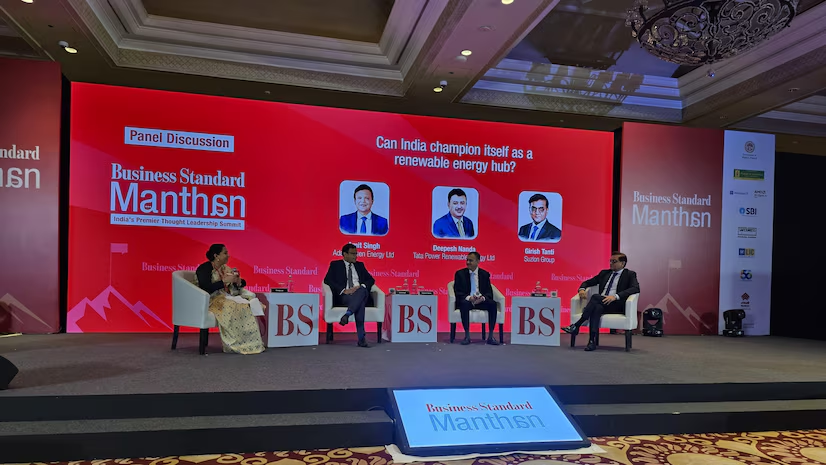Localisation of supply chains and talent development are key to making India’s renewable energy sector self-reliant and globally competitive, industry experts stress at BS Manthan
The renewable energy sector is witnessing rapid growth, with special focus on localising the supply chain to sustain this momentum, said Amit Singh, CEO, Adani Green Energy Ltd.
Singh stressed the significance of localisation in achieving this growth, stating, “If we want to move fast, we need to work on localisation of supply chain and talent. The sector is making an effort to localise — whether it is solar modules, wind turbines, or auxiliary equipment. Additionally, we need a larger pool of skilled professionals to support the sector’s expansion.”
Girish Tanti, founder and vice-chairman, Suzlon Group also believes that India is set to become a global supplier in clean tech. “But wind industry OEMs received no incentive in past 20 years.” he points out. “Some support is required to develop a wind ecosystem and make India a global supplier in wind energy tech,” he said speaking at BS Manthan.
Further, Singh emphasised the accelerating demand for renewable electricity and the need for large-scale projects. He said, “Renewable energy is rising at an accelerated pace. This is the era of renewable electricity, and eventually, everything will be electrified. The demand is growing rapidly, but we are still far from where we need to be. That is why we have taken on the challenge of a 30-gigawatt plant, which is well on its way. Today, we reached a milestone, crossing 12 gigawatts in total portfolio, and we aim to reach 50 gigawatts by 2030.”
Talking about import duties, Singh expressed the importance of long-term planning. “We need to think long-term, not just short-term. Localisation is essential at this stage, and support is needed for growth. Eventually, these support measures will phase out at the right time, but for now, they help businesses flourish.”

(L-R) Amit Singh, Deepesh Nanda, And Girish Tanti
Addressing the prospects of a 100 per cent domestic solar power plant, Singh highlighted the need for efficiency over cost alone,
“We should not look at pricing just from a cost perspective but also from how efficiently we operate the plant. Wind patterns in India vary, so the challenge is to optimise plant design to capture maximum wind energy. A micro-level understanding of weather patterns is crucial to lowering costs holistically,” he said.
On skilling, Singh said, “We invite people to come work with us even though they don’t have much experience around it. We give them safety training (around electricals). And parallelly, we are developing a training centre. And people we train will not just work with us, but will be free to work with the government. That is the team of people we need. The quality of workmanship is equally important otherwise we won’t be able to have plants that run in the long run.”
Deepesh Nanda, MD & CEO, Tata Power Renewable Energy Ltd, acknowledged the Indian government’s ambitious renewable energy targets, stating, “The government has set a target of 500 gigawatts, which initially seemed ambitious. However, today, if you ask industry leaders, they are confident we will achieve it. Our estimates suggest we may even reach 650 gigawatts by 2032.”
Nanda highlighted Tata Power’s role in this transition. “Like many large industry players, we have undertaken a massive expansion. We currently have 6,000 megawatts operational, with another 6,000 under construction. This has been enabled by government-backed manufacturing initiatives, particularly the PLI (Production-Linked Incentive) scheme. We benefited from this and commissioned a world-class manufacturing plant at scale.”
On balancing cost and sustainability, he said, “Going green is as much about cost as it is about environmental benefits. The cost of electricity is crucial, and with complex tenders integrating solar, battery storage, and pumped hydro, we can replace thermal power on a one-to-one basis at a competitive cost.”
Nanda also highlighted the need for investment in research and development. “India generates 18-20 gigawatts of solar energy annually, and we must ensure our manufacturing sector supports this growth. Investment in R&D is critical, and unfortunately, the industry has often fallen short in this area. The PLI scheme has been beneficial, offering incentives worth Rs 2,000 crore — an advantage few other countries provide.”
On challenges in setting up manufacturing units, Nanda said, “Today, every other month, you have an investor summit, like recently in Assam and Madhya Pradesh. The Indian states have become extremely careful and interested in attracting investments, and hence those hurdles are not there anymore. Actually, it is now becoming easier and easier for us (companies).”
Girish Tanti from the Suzlon Group, talked about the strides made in wind energy localisation. “We have seen significant growth in the wind sector. Currently, local content in solar is about 20 per cent, but we aim to increase it. In wind energy, we have already reached 64 per cent local content.”
He reiterated the importance of India’s self-reliance in clean energy, saying, “We are ticking all of the government’s boxes: clean energy, self-reliance, and the ability to supply globally. It would be a missed opportunity if we do not use this moment to build talent, create jobs, and strengthen ‘Make in India’. Localisation is the only way to generate employment.”
Addressing concerns about wind energy’s reliance on subsidies, Tanti said, “For the past 20 years, there has been zero incentive for wind energy. The industry has been operating without incentives — the support was for the end-user, not the supplier. Research and development are crucial for any industry’s success.”
https://www.business-standard.com/specials/bs-events/renewable-energy-india-localisation-growth-wind-solar-125022800385_1.html

